
| THE INDUSTRIAL RAILWAY RECORD |
© DECEMBER 1963 |
IRONSTONE TRAMWAYS
OF THE MIDLANDS
| (3) |
THE ORE MINING BRANCH |
by ERIC S. TONKS |
The ironstone properties of the Ore Mining Branch of the United Steel Companies Ltd. are confined to Rutland and Lincolnshire and can be conveniently grouped together for study. There have been quite a few changes since 1958, the most important, perhaps, being the opening of a completely fresh mining area, the only one since my book was published.

Easton Mine, lying about one mile north of Colsterworth on the British Railways High Dyke branch was first brought to the writer’s notice by members of the Railway Enthusiasts Club who observed work in progress during their rail-tour of the branch on 19th June 1960. Easton is a mine proper but, unlike Thistleton, the ore is brought to the surface by conveyor belt and not by a narrow gauge tramway, though a temporary one of 2’ 6" gauge was used during the preliminary operations. The only rail installation is the set of storage sidings; the latter, which are quite extensive, are located north of a level crossing officially titled "Burton Lane Crossing". There were B.R. sidings to the south of the crossing before O.M.B. cane here, and they are still there. Site preparation began in December 1958, and production commenced on 1st January 1962.
Ore from the adit mine is conveyed by belt to a gantry over one of the sidings; wagons in the storage sidings are let down by gravity to the vicinity of the gantry and then moved under the latter by a "spotting mule" installed by the Mitchell Construction Co. Ltd. of Peterborough. This consists of an electrically-operated trolley running on 2' 3½" gauge track between the standard gauge metals, and controlled by a lookout man in the gantry. At the upper end of its run, a hook engages with the leading axle of a set of four wagons, which are then hauled underneath the gantry for loading, and inched along as required to distribute the load; at the bottom end; the hook is disengaged and the trolley returns for another set of wagons. Marshalling of the full wagons into trains for collection by B.R. and pushing the empties into the storage sidings is carried out by a 200 h.p. 0−6−0 diesel-electric locomotive (Yorkshire Engine Co. 2744 of 1960), the first modern diesel to be put into regular use in the Midlands ironstone fields. It is painted in the standard O.M.B. livery of maroon, lined black and yellow, and carries the stencilled number 752/10 on the cabside. (It will be noted that it is not numbered in the 13xx series. Easton is not controlled by Colsterworth, but is a mine under the jurisdiction of O.M.B. headquarters at Treeton, near Sheffield; the number is a Mines plant no.). The locomotive is housed in a brick shed near the adit.
Colsterworth Quarries have changed very little in layout, but there have been considerable changes on the locomotive side. The stock was renumbered in a new series in October 1960 - for details see under Exton Park. Then Easton’s diesel came on trials for a few weeks late in 1960, and as a result two similar machines were ordered and delivered in February 1962 (Yorkshire Engine Co. nos. 2871 and 2872). They are painted in standard O.M.B. livery and carry running numbers 1381 and 1382 respectively in black on a yellow circle on the cabside. Complete displacement of steam at the East Quarries has resulted, but old No.38 was being overhauled in the shed in January 1963. When this is completed and she is repainted, No.38 will probably be despatched to the North Quarries and one or both of the Hudswell Clarkes scrapped. Both diesels work daily, in turn taking eight empties up to the quarry and bringing a full set back; the two trains pass each other in the loop on the way to the "No.2 Quarry", as the quarry at East is officially termed. Some very large excavating equipment is in use at both quarries.
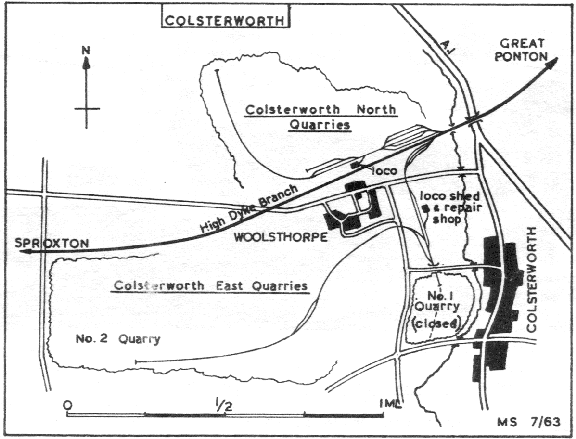
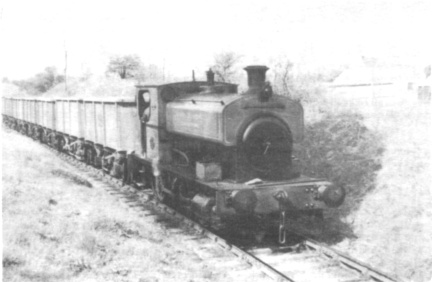
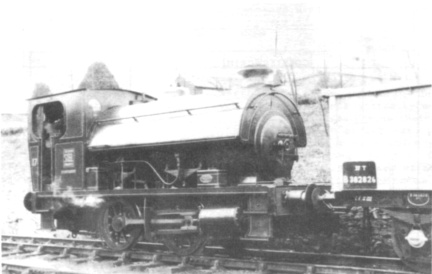
|
Colsterworth East in May 1960 |
|
|
Upper |
No.60 (Barclay 1378 of 1915) |
|
Lower |
17 (Yorkshire Engine 2435 of 1948) |
|
(S. Leleux) |
|

The shape of things to come? Diesel 1381 (Yorkshire Engine 2871 of 1962) approaches the level crossing at Colsterworth East on 18th April 1963. (R. Hateley)
Cringle Pit was closed in 1958, and 34 was sent to Colsterworth East and scrapped in December of that year. 29 remained, locked in the shed, until the following summer, when she too returned to Colsterworth East (between June and September). The equipment was otherwise left untouched pending a possible reopening, but this did not come about. Some track at the quarry end was removed late in 1960, and the whole site was cleared in 1962 - track lifted, B.R. connection taken out, and the locomotive shed demolished. Deep snowdrifts and a blanket of freezing fog precluded a detailed survey on the writer’s visit to the area on 24th January 1963, but he was assured that nothing remained.
Exton Park, where there have been a number of important developments, is undoubtedly the most interesting system from the railway point of view. In the Park itself, "full circle" has been in operation for some years now and, instead of operating two "pincers", the locomotives now work round in a clock-wise direction, three. or four trips a day according to requirements. The layout of this section, despite its size (the circle is some eight miles round), is of the simplest - rather like an early Hornby model railway set. There isn’t even a loop at the loading point, and as each loaded train departs another one draws up behind it alongside the excavator.

Let’s take a trip around. Leaving the vicinity of the locomotive shed, the southward line swings away to the right, while the northern line plunges into cutting which is practically unbroken for the next three miles. At first this was a drab featureless run but Nature has come to the rescue and transformed the first mile or so into a pleasant glade; birches and willows have clothed the tumbled slopes so that they look a part of the woods above; pheasants and squirrels run across the track. Just east of the road bridge a siding runs to a higher level but appears to be disused. Further east the cutting walls are progressively more recently worked and hence less overgrown, though much waterlogged; until, about three miles from the shed, the line suddenly curves to the south. Over to the left is the lake, well hidden in trees, and to the right farmland; a further short cutting follows and then the second arm of the lake, this time with the shores visible and many waterfowl in evidence. Another area of high ground is then traversed and this at present is the main quarrying area, extending roughly a mile, in the course of which the line swings north again. Quarrying commenced on the perimeter of the workable area and, as the ore is removed, the rails are slewed inwards to the new working face. On emerging from the quarried area the tramway runs due west, with extensive views of Exton village and the Park, to cross Barnsdale Avenue and then swing north to the vicinity of the shed again. There are three level crossings on the section by Exton village, electrically controlled from manned boxes.
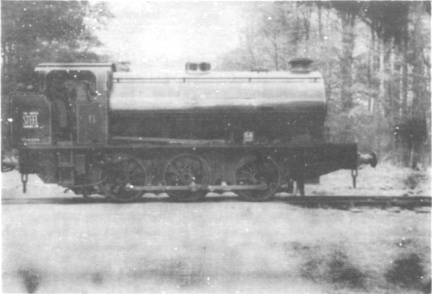
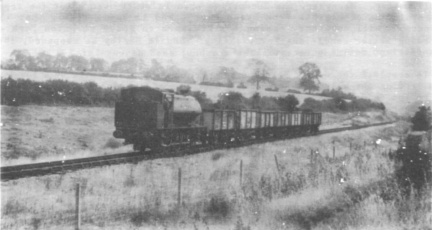
| Two photographs of Yorkshire Engine 2568 of 1954. | |
| Upper | Crossing Barnsdale Avenue the Birmingham Locomotive Club's open wagon special train over the Exton Park system on 7th May 1955. |
| Lower | Leaving the quarries with a full load on a misty day in September 1962. |
|
(J. Wallbank: |
So much for Exton Park Quarry itself. The Burley system was acquired from Dorman Long in 1957 and, as expected, integration with the Exton Park system is now complete. The strip of land separating the two tramways between the Cottesmore to Oakham road and Watkin’s Gorse was cleared of hedges and a trailing connection put in from the Burley line to the rear of Exton Park locomotive shed; this was brought into use about October 1961, ore from Burley being despatched by this route. The exchange link was also used by Burley engines JUPITER and BERYL coming to Exton Park shed for overhaul. The old connection to the B.R. line via Flint’s Covert was then redundant, of course, and it was lifted in the summer of 1962. The last rails were taken up in November but the two old Midland Railway signals were then still standing in isolation (though they had not been used for a very long time). Filling in of the route between the new connection and the Cottesmore to Oakham road commenced on 12th November 1962. The Burley system was not, however, to see much usage in this form, as recession in demand caused the Burley Quarry to be closed for production in July 1962. Two of the locomotives had been broken up the previous month (doubtless because of slackening demand) and the other two were despatched to Colsterworth for scrapping the following October. No further track has been taken up and the Burley system is complete (except for the loss of its B.R. connection, of course) and reopening would be a simple matter. Moreover, the locomotive shed is still used - for the repair and repainting of engines from Exton Park - and it seems likely that this arrangement will continue, easing the pressure on space at Exton Park and affording better conditions for painting. Should Burley be reopened, there is sufficient motive power available.
To complete the quarry description: Cottesmore South, served by a low level line leaving the main line near the locomotive shed, is also closed temporarily, and so too is Cottesmore North. These two were formerly the extensions of the 3’ 0" gauge system, and the North Quarries had latterly been worked by lorries. The route of the narrow gauge tramway is still very clear in this direction; it approached the Cottesmore to Market Overton road from the west, passed under it by a modern concrete bridge and then swung abruptly north, parallel to the road. The bridge is still there - the lorry crossing being nearby - and the cutting, at the upper end filled with goat-willow and other vegetation calls to mind Roger West’s reminiscences of "Pecketts working in sub-aquatic conditions" near the Barrow end of the system.
Locomotives now. With the disposal of the Burley locomotives, the stock is now wholly composed of two Yorkshire Engine designs, 16" and 18" (Austerity); but there are plenty of changes to record. In October 1960 a renumbering scheme was introduced whereby the quarry locomotives in the area became 1351-1370, the figures being painted on the rear of the bunker in black on a yellow disc. The old numbers have sometimes been removed, sometimes not. The various changes are tabulated below for all the quarries.
|
New No. |
Old No. |
Allocation history since October 1960 |
| 1351 | 10 | Exton Park. |
| 1352 | 11 | Exton Park. |
| 1353 | 12 | Exton Park; to National Coal Board, N.E. Division, No, 5 Area, North Gawber Colliery, Yorkshire, 1/1961; returned 6/1961. |
| 1354 | 13 | Exton Park (transferred from United Coke & Chemicals Co. Ltd., Orgreave, Sheffield, 2/1961). |
| 1355 | 21 | Colsterworth North; to Colsterworth East 1962; returned 1962. |
| 1356 | 26 | Exton Park (under repair at Burley in 11/1962). |
| 1357 | 27 | Exton Park (repainted at Burley in 1962). |
| 1358 | 29 | Colsterworth East; scrapped 10/1960 (new number not carried). |
| 1359 | 31 | Colsterworth North. |
| 1360 | 33 | Burley; to Exton Park 3/1961; to Burley by 8/1961; repainted at Burley in 1962; to Exton Park c10/1962. |
| 1361 | 36 | Exton Park |
| 1362 | 37 | Colsterworth East; repainted there 1962; to Exton Park 10/1962. |
| 1363 | 38 | Colsterworth East (under repair here in 11/1962). |
| 1364 | 39 | Exton Park (under repair at Burley in 11/1962). |
| 1365 | 60 | Colsterworth East; to Colsterworth North c8/1962; returned c9/1962; scrapped 10/1962. |
| 1366 | PATRICK | Burley; to Colsterworth East for scrap 10/1962. |
| 1367 | BERYL | Burley; to Exton Park for repair 3/1961; returned 1961 (?); to Colsterworth East for scrap 10/1962. |
| 1368 | 33 | Burley; scrapped 6/1962. |
| 1369 | JUPITER | Burley; to Exton Park for repair c1961; to Burley 3/1961; scrapped 6/1962. |
| 1370 | 17 | Colsterworth East; to Colsterworth North c7/1962. |
It will be noted that two of the Burley engines were repaired at Exton Park, though they can hardly have earned the £1,000 spent on them in their short working life subsequently. When Burley Quarry was closed the process was reversed, Exton Park locomotives being repaired in Burley shed. With the introduction of the "Austerity" type, maroon with black and yellow lining has become the standard livery; at the end of 1962 the only green engines remaining were 1356/61/63/64, of which all but 1361 were in works. Detail differences exist, as might be expected, but the general effect is very smart. The Burley engines repaired at Exton Park were turned out in a plain green. livery, according to Mick Lee’s information.

27 (Yorkshire Engine 2501) on 1st June 1952, just over a month after delivery to Exton Park. It is in the then standard green livery.